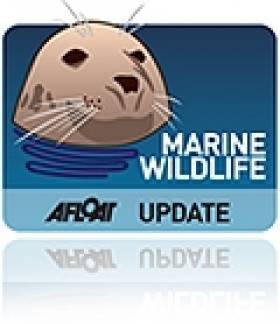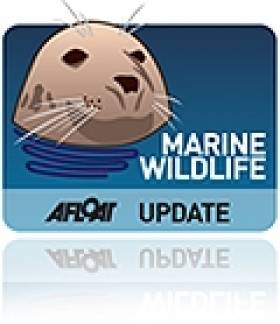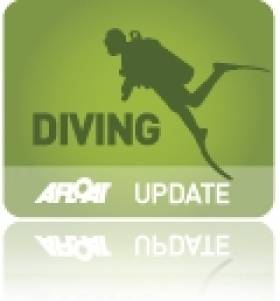Displaying items by tag: west cork
Boating Visitors To Ireland's South Coast Get Mixed Welcome Messages
#marinetourism – Ireland's south coast provides an almost infinite variety of harbours, natural havens, and extensive areas of interesting sailing water. These cater for boat enthusiasts of all kinds, with craft of every type. So how does the welcome for visitors shape up? W M Nixon contrasts the different hospitality styles of four attractive ports.
The word on the grapevine that the Ballydehob Old Boat festival had taken place arrived with an intriguing photo from Anthony O'Leary. It had been noted in the interview with him immediately after he had led the team in Ireland's Commodore Cup Victory, that while he was trying to unwind for a while, it's not really in the O'Leary makeup to relax, and soon his mind was busy with new ideas of nautical interest.
Nevertheless he was cruising gently in early August down towards West Cork in the family's handsome big Nelson powercruiser Irish Mist, a fast and able vessel which his father Archie and mates like Mick Ahern once took right round Ireland in a settled springtime spell of weather, just to be in Dublin to watch Cork Con play rugby in some major championship at Lansdowne Road.
As it turned out, this year Irish Mist was getting down west ultimately to be in Baltimore for the 1720 Nationals in late August, which O'Leary duly won. But from time to time, he flashed back some photos of interesting boats met along the way, and one which really rang the bell was a little Ette Class clinker-built gunter-rigged sloop sailing in Castlehaven.
The Ette class originated way way back, when two keen dinghy cruising types sailed their little dinghy into Castlehaven, and the Castletownshend locals in the South Cork Sailing Club were so taken by the boat that they commissioned the waterfront boatbuilders, the O'Mahony brothers, to build some sister ships as the basis of a class.
All the new boats' names ended in "ette". And the class survived for many years, though at times the Ettes were hanging on by a thread. But recently it has had a fresh lease of life with new examples of what is now a classic dinghy being built by Lui Ferreira of Ballydehob, who last came through this parish when, in 2012, he put the first teak deck on a vintage Howth 17, the syndicate-owned Deilginis.
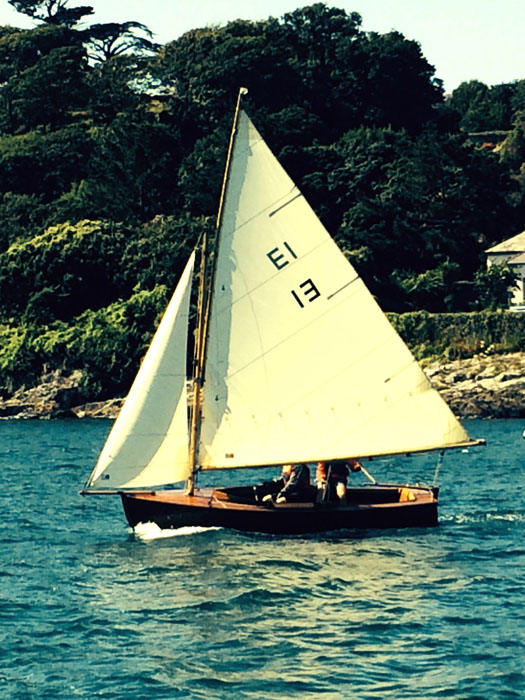
Perfection of summer – an Ette class in her home waters of Castlehaven. Photo: Anthony O'Leary
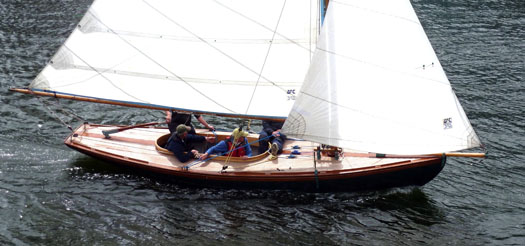 Rui Ferreira, builder in Ballydehob of the Ette Class, also put this teak deck on the 107-year-old Howth 17 Deilginis in 2012. Photo: W M Nixon
Rui Ferreira, builder in Ballydehob of the Ette Class, also put this teak deck on the 107-year-old Howth 17 Deilginis in 2012. Photo: W M Nixon
A Howth 17 looks well no matter how you photo her. But an Ette is a quirky little thing which can sometimes look odd from the wrong angle. Yet in a flash of inspiration, the Captain of the Commodore's Cup team took up his iPhone as an Ette came bustling down Castlehaven on fine sunny morning, and we got what I reckon to be one of the best photos of an Ette under way ever obtained – plus it gets the very essence of summer in Castlehaven.
The next O'Leary snap some days later was just briefly titled: "The Ballydehob Old Boat Festival, Irish Mist in archway second left". What was going on here? We'd heard vague stories about a very relaxed assembling of boat at high water at the drying quay at Ballydehob, but the O'Leary photo hinted at serious numbers and a high level of organization.

The teaser photo – first intimations of this year's Ballydehob Gathering of the Boats, with the O'Leary family's motor-cruiser Irish Mist (framed in the second arch from left) joining an eclectic group of 74 boats for a couple of hours at top of the tide. Photo; Anthony O'Leary
 This is most people's image of Ballydehob, crowded and very rural, with Mount Gabriel beyond. Only the more observant will notice the tidal river in the foreground. Photo: W M Nixon
This is most people's image of Ballydehob, crowded and very rural, with Mount Gabriel beyond. Only the more observant will notice the tidal river in the foreground. Photo: W M Nixon
To begin with, most casual visitors would scarcely think of Ballydehob as a seaport at all. Rather, it's the very essence of rural West Cork, a crowded little village where "laid-back" is the default mode, and it has been so for some time. It reached something of an apotheosis when Annie Barry (she's one of the Fergusons of Gubbeen Cheese) was running her wonderful Annie's restaurant on one side of the winding main street, and the Levis sisters Julia and Nell, feisty little ladies of mature years, were running Levis's pub across the way.
Julia and Nan were splendid folk of considerable standing, and it's said the pair of them were once squired to the West Cork Hunt Ball in Skibbereen by Jeremy Irons of Kilcoe Castle a few miles along the coast. As for the setup in Ballydehob, space was so limited in the restaurant that, having checked out your booking, you simply took up station in leisurely style across the street in the pub with Annie's menus and an aperitif or two, then Annie would come across the road and discuss your order, and a delightful evening would continue late into the night.
Alas, for some year now Annie's has been closed, though everyone lives in hope of somebody re-opening it. And in the pub, the old ladies have passed on. But now it's run by a great-nephew, and very successfully too. We got ourselves in there late on a velvet July evening this year to find the place was heaving with youth and beauty and high fashion in casual style - achingly trendy it has become.
It could have been a traditional local in any of the world's fashionable holiday areas except for one thing. A ball of fur, a terrier of some kind, emerged from among people's legs and barked its head off at me. I assumed it was because I carried a whiff of our own little Jack Russell. But the blushing girl owner told me with a big smile that her little dog must have thought I was a priest. Only along Ireland's south coast, near some former or still surviving Protestant enclave, would you have heard that particular excuse.
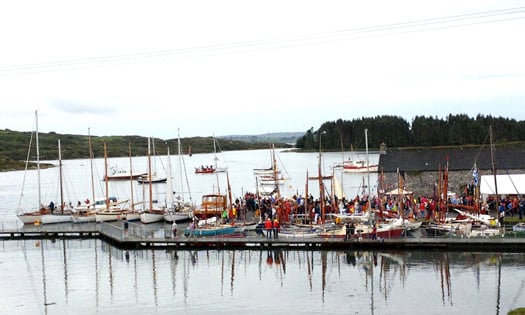 The old dock at Ballydehob is well able to receive a very varied fleet, seen here from the old railway viaduct Photo: Miriam Jones
The old dock at Ballydehob is well able to receive a very varied fleet, seen here from the old railway viaduct Photo: Miriam Jones
Just along the river from these scenes of hospitality and minor mayhem, immediately below the mighty railway viaduct which seems to be so disproportionate for the long-gone needs of the little West Cork Railway, there's Ballydehob Harbour. Time was when it was key to the place's economy, and it was in the late 1930s, only a year or so before World War II, that the Brooklands, the last surviving sail-only coasting schooner to deliver cargoes to West Cork, made her way up the winding estuary at the head of Roaringwater Bay (it's named for the Roaringwater River, much of the bay behind Carbery's Hundred Isles is well sheltered), to anchor just off the quay, as she was too deep to berth alongside.
The Brooklands was owned and skippered by Tom Creenan of Ballinacurra in the inner northeast reaches of Cork Harbour, but it was from Birkenhead or Goole on the Mersey that she'd bring her welcome cargoes of coal, a challenging passage at the best of times. At Ballydehob, while smaller cargo-carriers could get alongside the old quay, the Brooklands discharged her cargo into the multi-functional barge-type vessel known the Sandboat.
She was used by her owners, the Levis family, for just about everything, but primarily for going out among the islands towards high water, running up on a clean beach, then laboriously shovelling sand into the hold until the tide returned and the Sandboat could be floated off and piloted back to the quay where her eventually very useful cargo would be shovelled ashore to become builders' supplies.
The Sandboat was Queen of the Fleet at Ballydehob, and she played such a central role in the Levis family's life that Old Boat Festival organiser Cormac Levis's brother calls his pub in Ballydehob the Sandboat.
As for how Cormac himelf first got the notion for the Ballydehob Gathering of the Boats, he has been a tower of strength in the Traditional Boat movement, particularly in West Cork but also throughout Ireland, for many years. And with others following his example in restoring or even building new sailing lobster boats to traditional design, he suggested that getting together at Ballydehob during the little town's time-honoured summer festival around August 15th might hit the spot. And for the first one in 2004 –making this year's the tenth anniversary - they assembled nine boats, which was considered pretty good going.
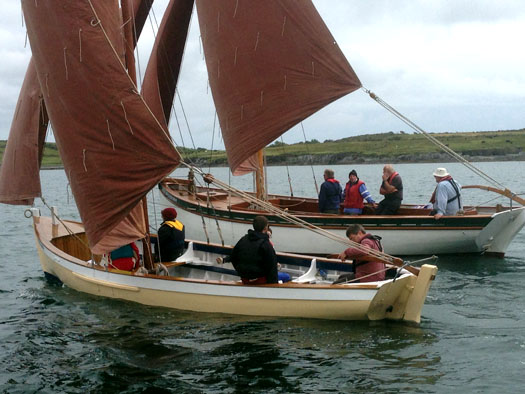
Close-up on Cormac Levis's lobster boat, which led the way for the first gathering of traditional craft at Ballydehob in 2004. Photo: Brian Marten
From it, they learnt that, for the future, while the aspiration would of course be for quiet and easy-going organization under a light hand, underneath it all there'd have to be efficiency, always with an eye on the clock. Although the tidal window is more than two hours for most boats, they've successfully accommodated modern yachts up to two metres draft without anyone being left behind stuck on the mud. But with limited manoeuvring space in both the harbour area and the channel, once the witching hour of high water is upon the fleet, it's time to start thinking about an orderly departure after two solid hours and more of good crack, mighty barbecues, and much interest in an examination of other people's traditional and classic boats.

Even among the sister-ships of the lobster fleet, many individual variants in hull lines and rig are apparent. Photo: Brian Marten

Just to add to the variety and colour, the Ilen Trust from Limerick brought their much-travelled Shannon Gandelows (right) to Ballydehob. Their stylish pennants are a legacy of heir successful visit to Venice at the end of April this year. Photo: Gary MacMahon
So the crucial thing is to select the ideal Saturday nearest to August 15th with a good big tide in mid-afternoon. As the Boat Gathering is such a force in its own right, they can range quite extensively on either side of August 15th, and to date the earliest has been August 8th, while the latest was August 21st.
This year's was Saturday August 9th, and while there may have been rain later in the day despite West Cork having much more sunshine in August than almost any other part of the country, no-body now remembers the rain as they recall the sheer fun and sense of community of what has been described by Tiernan Roe, another of the quality boat-builders of Ballydehob, as the "shortest bestest Boat Festival in the World".

Yet another creation of the active Ballydehob boat-building scene. This is an attractive little Cape Henry 21 cutter lunched in June by Tiernan Roe of Roe Boats. Photo: Tiernan Roe
For this year, it attracted 75 boats, though admittedly last year's record entry of 50 boats was greatly enhanced by this year's decision by the Drascome Lugger Association to combine Ballydehob in their 2014 cruise-in-company in West Cork, thereby adding 27 boats at a stroke.
But even with 27 boats of one class, the variety across the fleet as a whole was remarkable. So how do they assemble such a disparate fleet of boats with obviously highly-individual skippers, in such a quietly efficient way? For you'll never see or hear the Ballydehob Gathering of the Boats being publicly advertised all that much beforehand.
The method is perfectly simple. Everyone with an interest will know it is likely to be coming up on the agenda. So a month and more beforehand, Cormac will text them with the final date on a need-to-know basis. It works, and it sets the tone of quiet consideration for others and their boats in a very special festival in which some quiet sponsorship by CH Marine and West Cork-based German traditional boat fan Thomas Drewes sees that all participants get mementoes including cherished T-shirts (definitely not for general release), while barbecue facilities keep the good humour buzzing until everyone departs in style for their anchorage for the night, for although most boats hope to be berthed in Ballydehob on the big day more two hours hours before high water, once the ebb has started the channel has become much less forgiving about any pilotage errors.
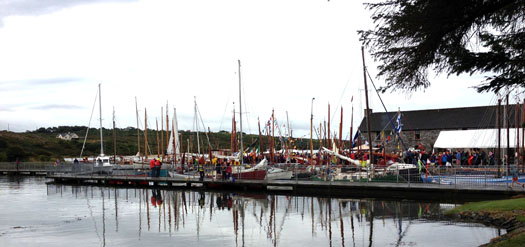
They're all here, as neatly berthed as you could please, but getting them away as the ebb starts requires good seamanship and boat-handling skills. Photo: Miriam Jones
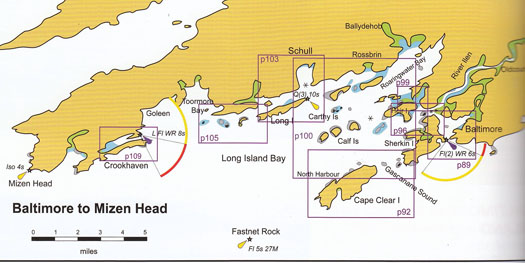
Ballydehob's central position in a hugely varied and welcoming crusing coast is emphasized by the number of other harbour chartlets indicated in this plan of the prime cruising area of West Cork. Plan Courtesy Irish Cruising Club
It's good to see a locally-focussed event like this now coming of age with a very healthy turnout. Eastward along the south coast, last weekend saw another event which will surely grow in stature and numbers, the second staging of Y2V Cruise-in-Company on the River Blackwater up the estuary from East Cork to West Waterford, as a flotilla of ten boats - eight GP14s, a Mermaid and a Feva – sailed up-river from Youghal to Villierstown.
It has been promoted by Youghal schoolboy GP 14 skipper Adrian Lee, and last year the inaugural tiny flotilla managed most of the sailable river by going to the bridge at Cappoquin before returning downriver to Villierstown. This year it achieved deserved support from the GP 14 class, with the furthest road-trailed from sea level being incoming Irish GP 14 Association President Stephen Boyle from Sutton DC, while the furthest-travelled in terms of elevation above sea level were the Blessington group, who came down from the Wicklow Hills with their Geeps and included Richard Street and kids (see again this blog on 26th July), and a brand new Duffin boat belonging to Simon Culley and Libby Tierney.
As for seniority, the classic of the class was a 60-year-old beautifully-restored Bell Woodworking GP 14 owned and skippered by 16-year-old Jack Nolan, another of that group of Youghal youngsters who are taking local dinghy sailing forward with gusto, while further variety was provided by Norman Lee of Greystones, his crew including the inevitable family pooches which are such a part of the GP 14 scene.
The sailing was mixed – as Norman said, in a river the wind will always be ahead some time, and though we think of the secret Blackwater Estuary as being fairly straight, in fact there are some quite significant curves. It took about four-and-a-half hours to sail up, and a brisker four hours to return on Sunday morning's ebb.
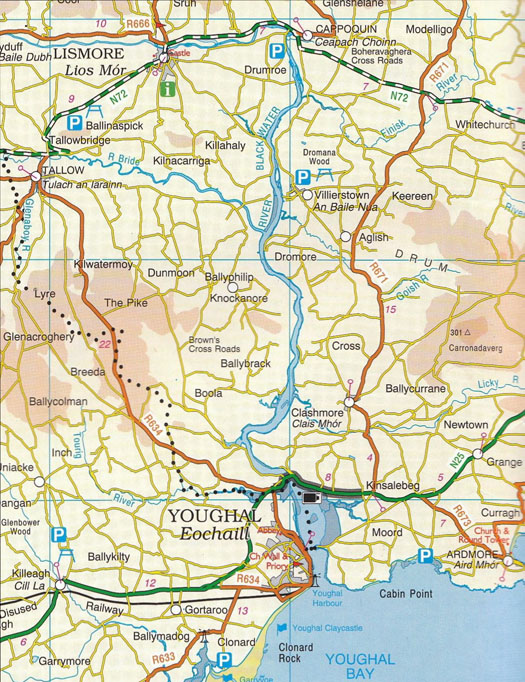
The secret waterway – the Blackwater Estuary from Youghal up to Cappoquin and almost to Lismore is one of Ireland's least-sailed rivers

Villierstown's new clubhouse, open only three weeks, was ready and willing to make welcome the crews who had sailed up from Youghal. Photo: Norman Lee

The new facility, Villierstown's "floating pier"
(right), was originally the in-harbour pontoon at Dungarvan SC. Photo: Norman Lee
At Villierstown, the new clubhouse of the Villierstown Boating & Activites Cub had been open only three short weeks, but they've made good use of a sports council grant, and it well fulfills a multi-purpose role, including providing the hospitality needed by sailing campers, with Paul Virtue and his wife Caroline organising a fine feast in the clubhouse on the Saturday night, and an enormous breakfast on Sunday to send them on their way downriver to round out an event which has future annual success written all over it.
One of the reasons it all went so well was that the slightly cogglesome little plastic floating jetty, along which the sailors of Villierstown used to access their small boats, has been replaced by a proper pontoon which the club acquired when Dungarvan SC eastward along the coast up-graded their in-harbour pontoon. In fact, Dungarvan support for the development of Blackwater sailing didn't stop there, as one of the fleet in the Y2V was a vintage Dungarvan-based Mermaid in which owner Eugene Burke has cruised the entire south coast between Ballycotton and Kilmore Quay.
The boat is Akita, Mermaid No. 85, and she has certainly been around, as she was built in the Barkyard in Skerries in 1953 by Joe and Matt Boylan. The Barkyard was originally the place where the Skerries-based coasting schooners and fishing boats had their sails preserved against rot by tanning with bark, but in the 1950s the now redundant premises were used to build some of the eventually enormous fleet of Skerries Mermaids through a boat-building class run by the colourful Jem Kearney.
The Fingal region around Skerries and Rush continues to be the great heartland of the Mermaids, with some very racy boats built in the old mill at Rogerstown recently, but despite the modern challenge, this year's Mermaid Week at Rush saw the champion emerge in the form of Jonathan O'Rourke of the National YC with his vintage boat, one of the few Mermaid sailors still in Dun Laoghaire.

The welcoming port. Despite its tidal limitations, Dungarvan lays on the welcome in a big way. This shows a visiting fleet at the original pontoon, which has now been moved to Villierstown. Photo Kevin Dwyer, courtesy Irish Cruising Club
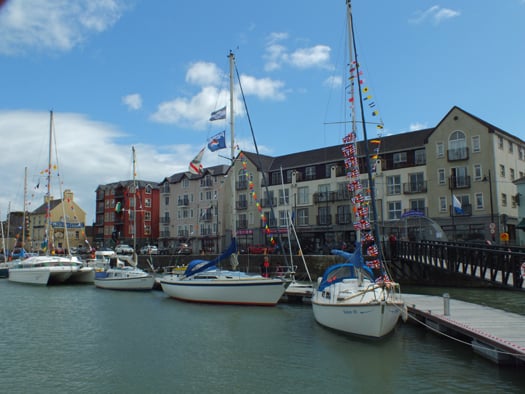
Dungarvan SC's new in-harbour pontoon has much improved the alongside berthing space, but unfortunately the local Council wouldn't permit dredging to improve access.......Photo: Donal Walsh

....and thus the reality for most boats in the Inner Harbour is a drying berth.......... Photo: W M Nixon
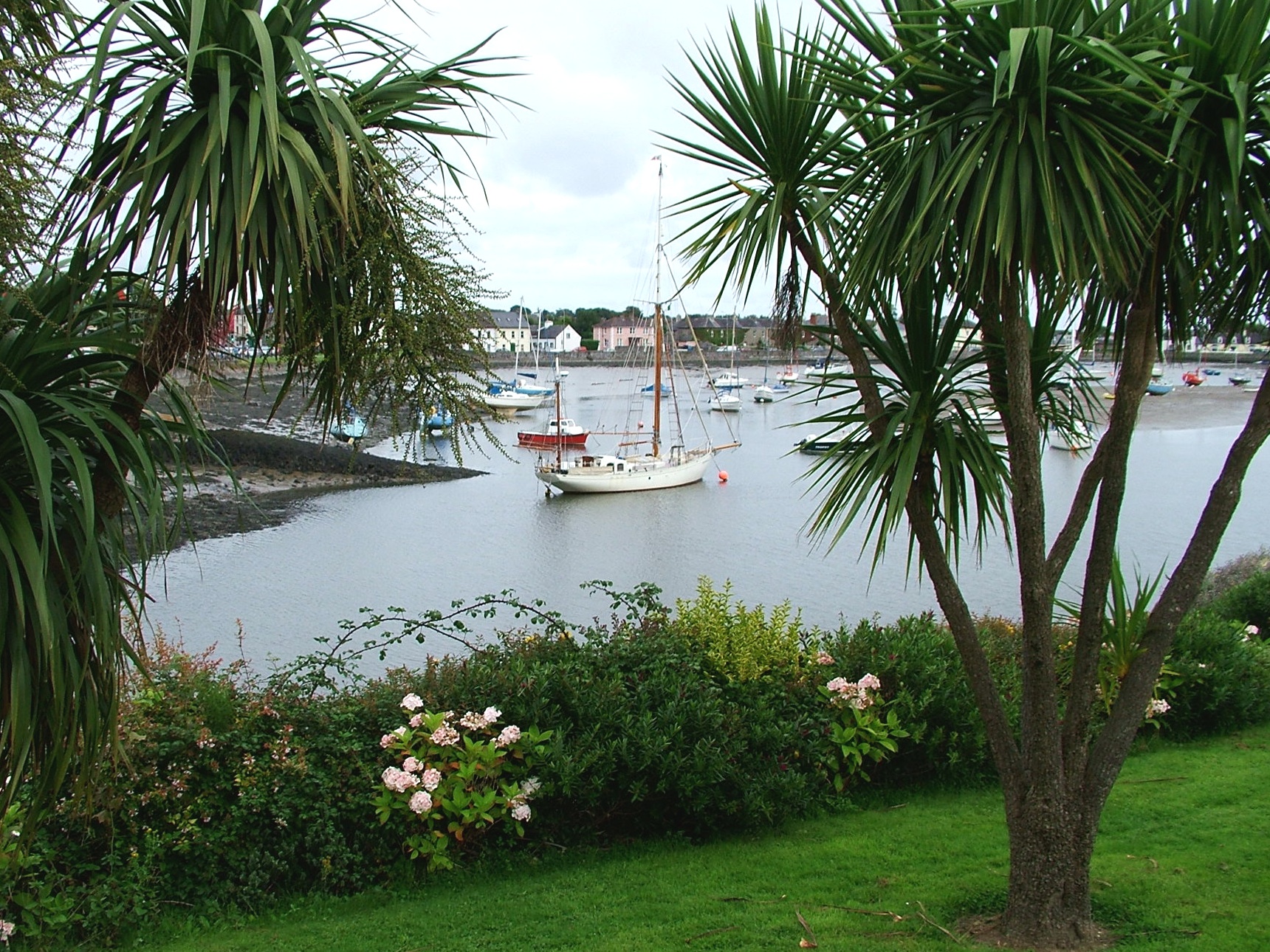
....but if you've access to local knowledge, there is a deep pool just below the bridge........Photo: Donal Walsh
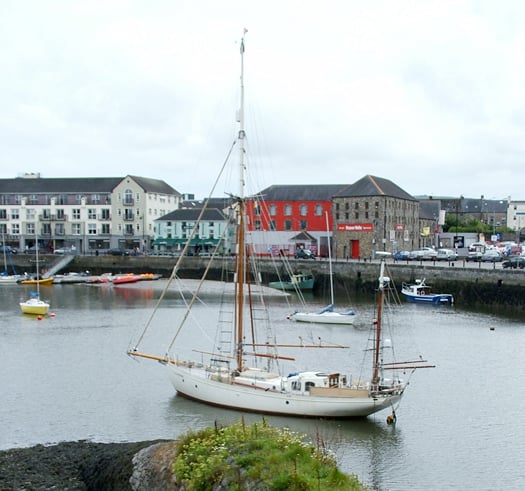
.....and here the Northwest Passage transiting 44ft steel gaff yawl Young Larry is visiting in comfort and style. Photo: Donal Walsh
Meanwhile in Dungarvan the club's hopes of doing a bit of dredging to improve access to their extended in-harbour pontoon was stymied when the council said they wouldn't permit any salt-contaminated sludge being brought up onto the quay. But despite its tidl limitations, it's a hugely hospitable place, and if you do take the ground at the pontoon, it's mostly soft and forgiving mud which enables you to sit in relative comfort. Certainly some very substantial cruising boat have overnighted here to enjoy the fine pubs both on the waterfront waterfront and in the town, while culinary standards are set by Paul Flynn's famous restaurant The Tannery just round the corner.
Nevertheless if you absolutely won't let your boat dry out, leading Dungarvan cruising man Donal Walsh (he has just returned from an epic round Ireland and Britain clockwise cruise with his Moody 31 Lady Kate) well knows the deep pool across the harbour close under the bridge, and he saw to it that his brother-in-law Andrew Wilkes and sister Maire Breathnaith found a secure berth there for their hefty 44ft steel-built gaff yawl Young Larry, a boat in which they transited the Northwest Passage, but she looks well at home in Dungarvan with its fine tradition of first class locally-based trading schooners.
In moving along the south coast, we find that when possible, they'll lay out the welcome mat big-time in Ballydehob, Youghal, Villierstown and Dungarvan, despite the fact that all four places are restricted in what they can do by the exigencies of tide.
So how are things working out in Dunmore East, the one port which has the potential to be one of the most welcoming and accessible all-tide sailing and fishing ports along the entire south coast?
Despite this potential, the under-development of its facilities, fuelled by a sometimes poisonous attitude between fishermen and other harbour users, has provided recreational visitors with often unpleasant memories. In trying to understand why this might be so, we have to understand how Dunmore East came to get its pretty little harbour. When it was built in the first half of the 19th Century, it was not – as is commonly supposed – built for the benefit of fishermen. The horrible fact is that fishermen came so far down the pecking order that they just had to make do for themselves as best they could.
The handsome new pier at Dunmore East, designed by Alexander Nimmo who is best known for developing Tobermory in Scotland and many places in Galway including Roundstone, was constructed exclusively for the use of the new fast sailing cross-channel packet boats serving the top people of Waterford in their trading and communication with Britain, while the unfortunate local fishermen were forced to keep their boats in the limited shelter of The Cove to the north of it, and haul them on the exposed beaches at The Strand and Councillors Strand.
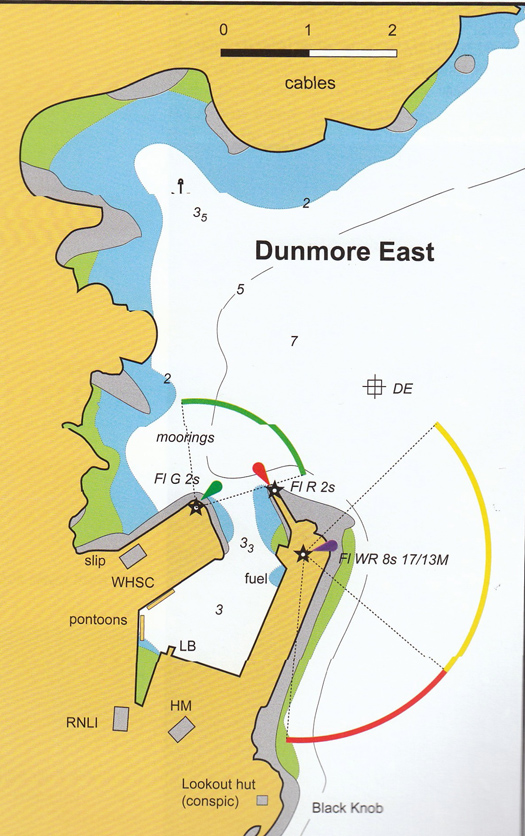
Dunmore East's substantial pier was new-built originally to provide a port for cross-channel sailing Packet Boats, serving Waterford ten miles up the road. When this was its primary function, any local fishermen were banished to the poorly-sheltered coves to the north, with their boats being hauled up on the exposed beaches beyond. Plan courtesy Irish Cruising Club
Soon, however, steam driven packet boats were able to go conveniently all the way up to Waterford, and Dunmore East was redundant as a packet-boat harbour. But it was only with reluctance that fishing boat were allowed to start using it, as the Royal Navy would have been keeping an eye on its possibilities for their own occasional use.
Yet down the years, the idea has developed that Dunmore East was always primarily a fishing harbour, and to a lesser extent the same attitude prevailed at Howth on the east coast, where the new harbour functioned as the Packet Boat station for Dublin only between 1817 and 1826, when the developing new asylum harbour at Dun Laoghaire became the selected port for the Royal Mail's new paddle steamers serving the cross-channel route. Yet the silted harbour at Howth was only allowed to become a "fishing station" in the 1850s.
The legacy of all this, in Dunmore East at any rate, is that there still seems to be a suspicion among the fishing community that their tenure is only temporary, that the powers-that-be would move them out if they see a better use for the place. How else can we explain the negative and almost paranoid attitude of the fishing spokesmen every time a suggestion for a much-needed marina at Dunmore East is put forward?
With all this in mind, I made a quick visit to Dunmore East in mid-August while on other business in the southeast, in the hope of seeing if a much-trumpeted €4 million dredging scheme was now in progress in the harbour, and also to see how an equally celebrated new Visitors Pontoon along the East Pier was working out.
The photos speak for themselves. There wasn't any sign of a dredger, though doubtless that will turn up in due course. Yet as for the 40 metre pontoon, it's not a leisure-boat-friendly neat little piece of work at all, but is quite a massive and brutal steel box structure more suited to rugged fishing boats, who were showing their approval by using it so totally that the only leisure visitor was a German motor-cruiser which had managed to squeeze in at one end.
But as this pontoon is on the wrong side of the harbour for ease of access to the Sailing Club on the west side, and the welcoming facilities in the village above it, any pedestrian boat visitor – the vast majority of incoming leisure boaters, in other words – has a long trek through the sometimes crowded and malodourous delights of a fishing port before they can access any amenities. So not surprisingly the German boat had its inflatable tender moored outside it for quick and easy movement across the harbour, and along to the beaches if wished, a situation which inevitably precluded any other newly-arrived boat from rafting up alongside
So for any cruising boat coming in from sea, often with the challenge of Hook Head just recently put astern, it wasn't a welcoming setup. In fact, it was downright hostile. While we were there, an ordinary sailing cruiser with happy folk aboard came motoring from the eastward to round the end of the pier after stowing their sails, but their hopes of a convenient and enjoyable visit to Dunmore East were soon dashed. No welcoming RIB came out from the sailing club to direct them to a vacant mooring, as there probably wasn't one. And as for the pontoon, "unwelcoming" is inadequate. It clearly didn't want anything to do with them. You could see their spirits wilting as they headed out, faced with the long haul up to the marina in Waterford City. The current visitor berthing situation in Dunmore East is at the very least a sad business, so where does it go from here?

Dunmore East in mid-August. No sign of any dredging, and the "Visitors Pontoon" under the lighthouse on the East Pier is packed out with fishing boats.......Photo: W M Nixon
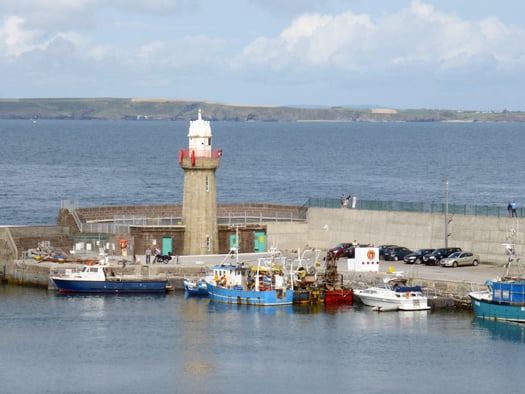
........and just one visiting German motor cruiser which was protected against any rafting up by its tender on the outer side. Photo: W M Nixon

The new pontoon is an industrial standard piece of kit......Photo: W M Nixon
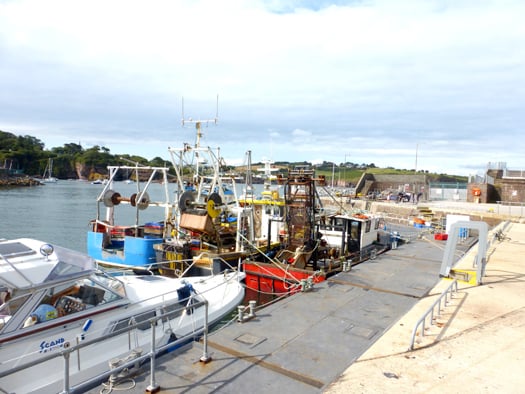
....and understandably very popular with active fishing boats. Photo: W M Nixon

But for visiting sailing boats newly arrived in port.......Photo: W M Nixon
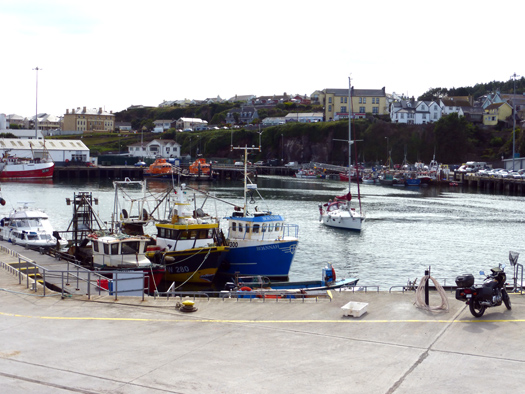
....it's soon clear that there isn't really a welcoming berth for them.....Photo: W M Nixon
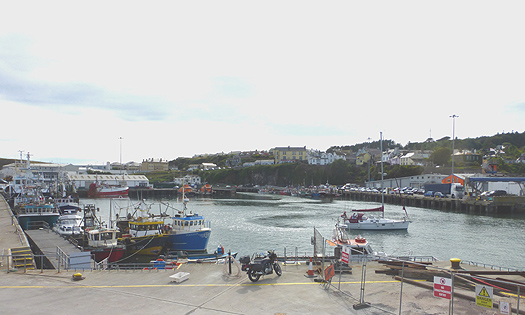
....and they head out to sea again, visibly disappointed by their Dunmore East welcome. Photo: W M Nixon
Dolphin Killed By Plastic Beer Can Ring
#MarineWildlife - A juvenile dolphin has died in West Cork after getting its beak caught in a discarded plastic ring from a multipack of beer cans, as the Irish Independent reports.
Locals were shocked to find the common dolphin in distress near Schull Harbour unable to free itself from the plastic, and after a lengthy struggle it died shortly afterwards.
Plastic rings from multipacks of beer or soft drinks cans have long been a blight for animal life as they can easily be snagged in the tight, tear resistant plastic.
Independent.ie has more on the story HERE.
#MarineWildlife - Late summer brings fin whales flocking to West Cork in big numbers, with the Irish Whale and Dolphin Group estimating at least 20 of the second-largest ocean species sighted between Seven Heads and Galley Head.
Indeed, as IWDG sightings officer Padraig Whooley writes, the gathering "is certainly the largest validated aggregation of this species so far this year" and comes some months ahead of the usual peak from October to December.
Recommended spots for watching these fin whale visitors - though you will need some decent binoculars to get the best views - are the aforementioned Galley Head and Seven Heads as eel as Cloghna Head, Dunworley and Sandscove.
Kerry has its own share of whale visitors, with a "lovely run" of humpbacks in recent weeks, while East Coast residents aren't left out, either, with a rare sighting of a minke whale in the Irish Sea some 20km off Bray Head over a week ago.
In other cetacean news, West Cork has become home to a new solitary dolphin in the form of Clet, a bottlenose who's been spotted in Glandore, Baltimore and Schull after time from Devon, Cornwall, South Wales and originally France.
Yet as IWDG welfare officer Paul Kiernan warns, Clet might appear cute but he's very much a wild animal, with reports claiming a swimmer off Sherkin Island was "aggressively pushed underwater by the dolphin".
Such stories, Kiernan writes, point "to the need for people to exercise common sense and extreme caution in how best to enjoy an interaction with this very large, apex predator."
He adds: "Bottlenose dolphins are not cute and cuddly, they are not our 'friends' and nor do they benefit in any meaningful or long term way from interacting with humans."
Entry Boost Gets Calves Week Off to a Flying Start
#calvesweek – There has been a marked increase in entries to Calves Week this year writes Claire Bateman. Entries are up 25% with boats coming to Schull from clubs around the coast for the 4 day regatta. Boats from Waterford and Kerry Sailing Clubs are joining the usual strong contingents from Kinsale, Crosshaven and Dublin, and a few new visitors from the UK completed the strong racing line up. With 15 boats competing in some classes, some great days' racing is promised in the Cork Dry Gin sponsored event.
With light winds from the south east backing south forecast for the starting day's racing, Race Officer Neil Prendeville kept the starts clean with separate guns for the four cruiser classes as well as the two Whitesail classes outside Copper Point. He chose a windward course for the fleets out around the Calf Islands. The cruisers were able to hoist their spinnakers from a laid mark south of West Calf Island with a leeward run back to the Amelia Buoy. Class 0/1 completed 3 rounds with the other classes completing fewer laps. A sailing breeze picked up, allowing the various fleets the opportunity to complete before the weather unexpectedly closed in.
With a spread of entrants from sailing clubs around the country, racing competitively against each other, winners were produced from around the country. Conor Doyle in Freya from Kinsale YC) took line honours and won Class 0/1, IRC ahead of Colman Garvey in True Penance (RCYC) and Rob McConnell in Fools Gold (Waterford Harbour SC). In Echo, Freya again took the honours, ahead of local boat Infinity with Dave Harte and Des Cummins in Dear Prudence (RStGYC). In Class 2 IRC while Dexterity from Foynes YC (McEneff/Madden/Hobbs) took line honours, on corrected time the day went to Frank Desmond, RCYC, on Bad Company ahead of Derek Dillon, Foynes YC, in Big Deal and Viking with Robert Dix/Brian McKernon (Howth YC). Big Deal took Echo honours, ahead of Val Kriss (Nigel Dann, KYC) and Bad Company.
Class 3 saw a 1:2 punch for Cobh SC, with Billy Burke and Danny McCarthy's Sigma 33, Muskateer, first over the line in Class 3 and rewarded with first in both IRC and Echo, ahead of Adrian Tyler on a Hunter Impala, Whyte Knight. Jimmy Nyhan on Outrigger (RCYC) and Padraig O Donovan on Chameleon (KYC) took third in IRC and Echo respectively.
Saoirse, under Richard Hanley from Kinsale YC won Class 4 IRC and Echo respectively, ahead of local boats Witchcraft (Simon Nelson) and Barossa (Edmund Krugel) in Echo.
In the fleet of larger whitesail boats, John Dowling in Samba (RCYC) crossing the line first and getting both IRC and Echo honours. Ger Hayes' First 36.7, Y-Dream took second in both handicaps. Dufour 425 Act 2 (Roche, O'Leary, Andrews) took third place in IRC, and new entrant Samatom, a UK based
XC45 sailed by Bob Rendell, was third in Echo. In Whitesail 2, Ashanta took IRC honours, with local boats Aoife under Hugh O'Donnell, and Giggles under Peter Morehead, first and second in Echo, ahead of Calypso, another UK based boat under John McCarthy (MBSC).
In keeping with friendly nature of the club, any newcomer to Schull has been offered a "buddy boat" – a local captain to share important details like the need for attention to the local sailing hazards and where to get a good meal after an
West Cork RIB Adrift Prompts Baltimore Lifeboat Call Out
#ribs – At 20:48 last night Baltimore's RNLI all weather lifeboat was alerted to a Rigid Inflatable Boat (RIB) adrift four miles south of Glandore in West Cork. The lifeboat proceeded to rendezvous with the two young men who had been en route from Cork to Baltimore when their engine failed.
Crew member Diarmuid Collins went aboard the RIB to establish a tow. The lifeboat then towed them to the safety of Baltimore Harbour.
On board the 'Alan Massey; lifeboat were Coxswain Kieran Collins, mechanic Brian McSweeney, Pat Collins, Diarmuid Colllins, Tadhg Collins, Jim Baker, John O'Flynn.
The Sailing & Boating Wonders of Ireland's West Cork Coast
The sailing paradise of West Cork on Ireland's south-west coast is at its best right now, and the south coast fleets are already heading that way for the traditional West Cork regattas in August. WM Nixon reflects on the magic sailing region of West Cork.
West Cork is as much of a frame of mind as a specific place. Officially, we might suppose it to extend all the way along the Rebel County's coast from the Old Head of Kinsale to Dursey Island away in the far nor'west, up at the north side of the wide entrance to Bantry Bay. But this doesn't necessarily mean that all the folk in the hinterland north of this coastline see themselves as being in West Cork.
As for boat people, our limits are much more narrowly defined. If you're afloat down there, West Cork is that sublime but compact bit of coastline between Galley Head and Mizen Head, just 38 miles as the gannet flies. It's the ultimate lotus land, with an interesting scattering of islands, blessed moreover with an abundance of sheltered natural harbours each with its own port town or village vying with its neighbours in colourful character. And visible from much of it is the Fastnet Rock, mysteriously a place of the remotest ocean despite being only a matter of four miles from the nearest land at Cape Clear.
In this magic land, the local mini-capital is of course Skibbereen, the very essence of a rural market town. But on the coast, the very different harbours of Schull, Baltimore, and sometimes even Glandore have been seen over the years as the sailors' capital of West Cork. Recently, however, it is Baltimore which has gone from strength to strength to affirm its position as the sailing capital of the southwest, and spending a June night there as summer settled comfortably over Munster reinforced the impression of its pre-eminence.
We were on a bit of a land cruise, so the bed for the night was in the Waterfront, the hotel where Room 12 is just about as near to the beating heart of Baltimore as you can get. Aboard a cruiser in Baltimore, you can enjoy that splendid isolation which a boat so easily confers. But in Room 12 on top of the Waterfront's northwest corner above the square, the busy life of the little port town bubbles about you, and the views across to Sherkin Island and over the country to Mount Gabriel get even more perfect with the approach of sunset.
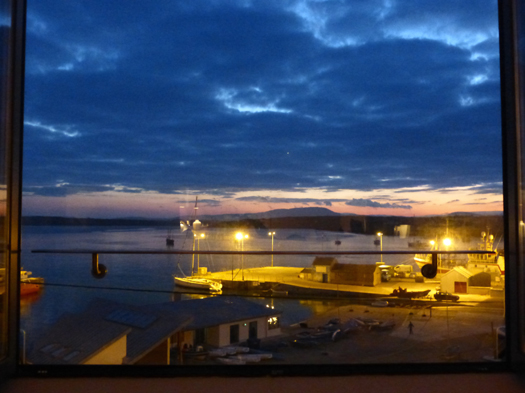
The view from Room 12 at the Waterfront in Baltimore. The sun has set beyond Mount Gabriel, but somebody is busy launching a newly-arrived RIB by floodlight, and the buzz from the square below is still rising. Photo: W M Nixon
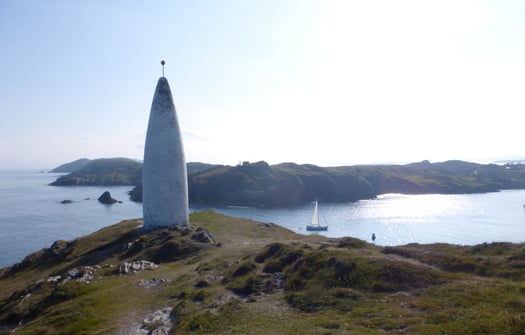
It has to be one of the best arrivals in world sailing. A cruiser enters Baltimore beneath the Baltimore Beacon, aka Lot's Wife. Photo: W M Nixon
It was fifty years ago when I first sailed in to Baltimore, coming in from the west on a round Ireland cruise, and entering port close under the beacon – Lot's Wife they call it – to find a quiet little place which showed some signs of a former prosperity, and hinted at better times to come. Back in 1964, it still had its railway station, but the West Cork Line was in its final year and was soon to be totally closed. Before that happened, later that summer when Baltimore Sailing Club hosted Dinghy Week for the Irish Dinghy Racing Association, the Firefly Class in Dun Laoghaire – mostly university boats – had been able to have a Tuesday night race. Then they'd towed their boats into Dun Laoghaire station on the launching trolleys, put them onto a CIE flat truck, and found them on Friday night safely delivered by rail the entire way to West Cork, offloaded ready at the harbourside station in Baltimore, and waiting for the arrival of thirsty crews keen for a bit of sport.
Mostly, they'd got themselves there by overloading some little car belonging to somebody or other's mother, so the fact that they disdained to use the railway themselves would help to explain why such a charming amenity was doomed. Since then, of course, Baltimore Railway Station from 1969 until recently had become Ireland's first Glenans base. But life moves on, the Glenans model doesn't seem to work any more in Ireland, so now the former station is for sale by the powers-that-be, and there are ructions being raised about it all which should keep everybody nicely exercised through the rest of the summer.
It was another French import which currently sets the pace in Baltimore. Around 1980 a young Breton fisherman, Youen Jacob, came into the harbour, and in time he settled there. To say that Youen Jacob has played a major role in Baltimore life is understating the case. It is he and his family who have developed the Waterfront – quite a challenge in somewhere as conservative as West Cork – and with Youen Jnr's Jolie Brise restaurant and guest house beside it to provide an alternative aspect of good Breton cuisine, the Jacob family's establishments have given a healthy new configuration to Baltimore's miniature harbourside square, and have settled in so well you could be forgiven for thinking the little town was built around them.
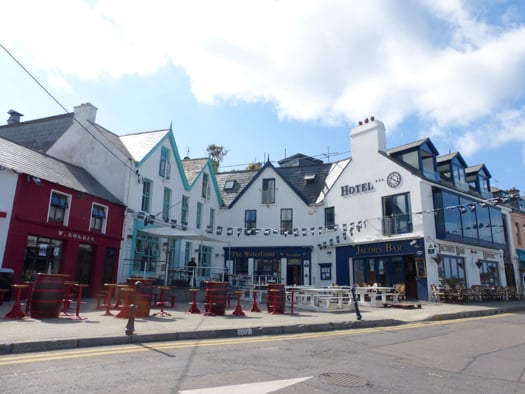
The Waterfront (right) and Jolie Brise at the south side of the mini-square in Baltimore bring a welcome breath of Brittany to West Cork. Photo: W M Nixon
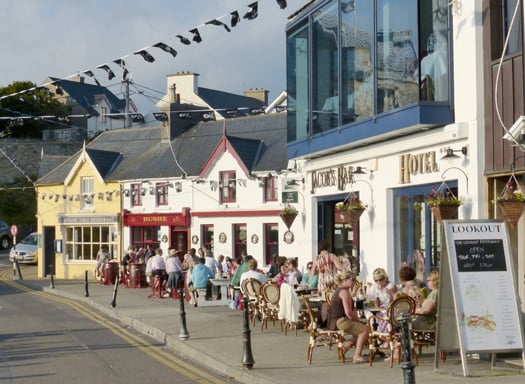
It's party time in Baltimore. The al fresco lifestyle is expected in West Cork in summer. Photo: W M Nixon
There are times when you'd understandably think this is the hub of the maritime universe, and why not? But if, during a quiet cruise, you think you might find it too hectic at night when the joint really is jumping, the sensible thing is to call by at lunchtime when everybody is out at the islands and Baltimore is refreshed and catching its breath for the next night's partying. Then in the evening, you can pop over to Sherkin Island where peace will reign while Baltimore ramps up the socializing.
Up in our eyrie above the square, we savoured the life of this busy little port. It's not quite a 24-hour town, but late at night boats were still being launched by floodlight, and conviviality continued in the square. Finally, peace descended, and though most folk were slow to stir early in the morning, the first ferries were coming in, and a workboat headed out for the islands, going past Graham Bailey's Peel Castle, the remarkable bisquine-rigged variation on a 50ft 1929-built Cornish lugger which is seen at her best on her mooring in Baltimore harbour. This is only right and proper, as the restoration and re-configuration of Peel Castle took place nearby, just up the Ilen River at one of the boatyards at Oldcourt.
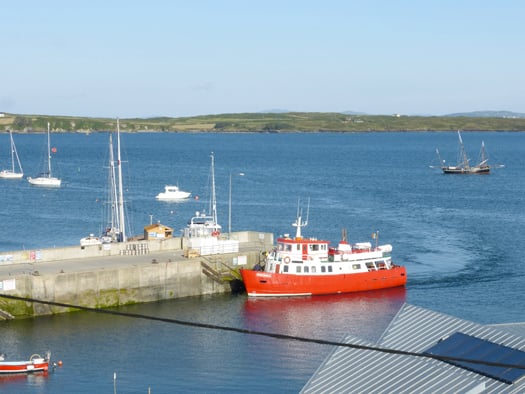
Good morning Baltimore, how are you? The first ferry arrives in from Sherkin Island. Photo: W M Nixon
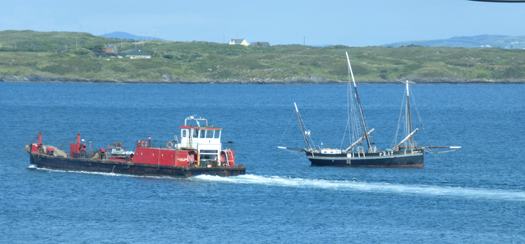
Getting the day's job started. A workboat heads out towards Sherkin past Graham Bailey's distinctive Peel Castle. Photo: W M Nixon

Peel Castle in all her glory in the middle of Baltimore Harbour. Restoring this 1929-built 50ft Cornish fishing boat and giving her a bisquine rig took Graham Bailey eight years of dedicated work at Oldcourt. Photo: W M Nixon
Another Baltimore revival which gets our approval is the restoration of the castle right in the middle of town, the "tigh mor" which presumably gives the place its name. We suffer from a widespread ruins overload in Ireland, so it's refreshing to find that somebody upped and took action, brining a ruin back to life and giving Baltimore a very effective signature focal point with a useful function. You could do the same to good effect at Dromineer on Lough Derg, where the ruined castle is an eyesore.
But you don't even have to leave the Baltimore area for a worthwhile restoration project, as just across the harbour beside the pier on Sherkin is the roofless ruin of the 15th Century Franciscan friary which we know looks much better with its roof back on, even if it has been missing since the 1770s.
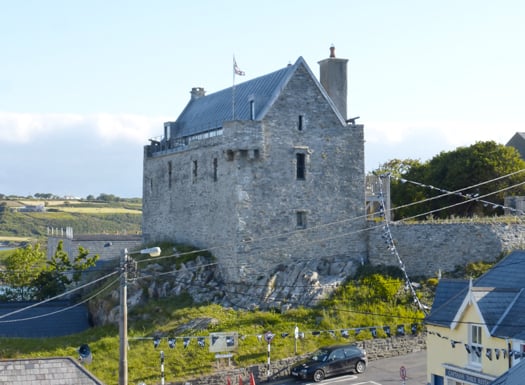
The restoration of the castle at Baltimore has given welcome and useful new life to a former ruin. Photo: W M Nixon
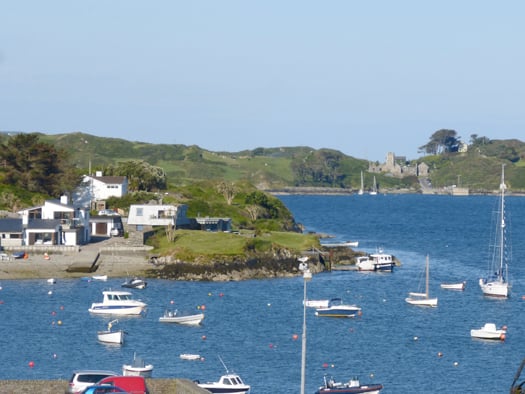
The Cove on the south side of Baltimore Harbour has some very desirable real estate. Photo: W M Nixon
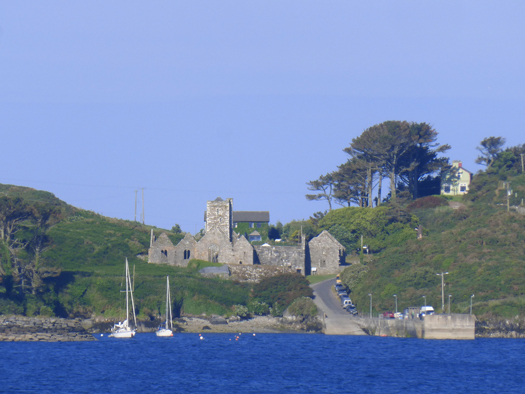
Thanks to its use as a film set in 1973, we know that the friary on Skerkin Island looks much better with it roof in place. Photo: W M Nixon
We know this because, in 1973, the makers of a TV film managed to get permission from the OPW to put a temporary but very convincing roof in place, and it looked so utterly right. The film was the unfairly forgotten Catholics, based on the novel of the same name by Belfast-born Brian Moore, and memorably starring Trevor Howard as the troubled Father Abbot. Even in this usually overlong blog, there isn't space to go into the details of the story, but it's worth viewing Catholics at the very least to see how well Sherkin friary looks with a roof. Alas, when filming was done the production company religiously (how else?) adhered to the OPW's demands to return the very attractive little old building to its ruinous state, and there it sadly sits.
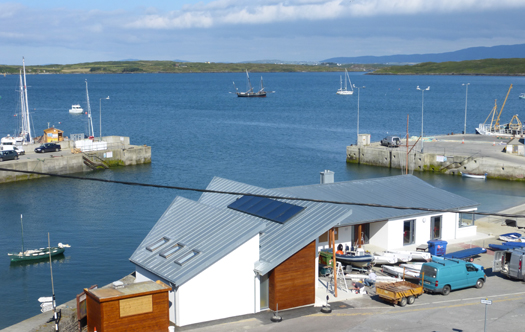
This year's work on Baltimore Sailing Club has made it even more of a local asset. Photo: W M Nixon
But as regular readers of Afloat.ie will know, other refurbishment and extension work has been under way in Baltimore, with the Sailing Club in fine fettle in its extended premises which look so well you'd think it's all new. It's certainly all of a piece with Baltimore's vitality, which contrasts with other little West Cork ports. In Baltimore, the key to it all is the fact that the Waterfront gallantly stays open all year round. But at present in Schull and Glandore, the main hotels don't even open in summer.
Doubtless in time, and sooner rather than later, both establishments will be brought back to life. But for people genuinely cruising, the absence of a hotel or two doesn't matter that much in an area where the abundance of cruising options and hospitable pubs with good food is almost bewildering. And around Baltimore in particular, there's always something going on.
The wholesome 1893-built cutter Eva (later known as Guillemot) was restored at Oldcourt, which is only a few miles from her birthplace 121 years ago on the Baltimore waterfront. Brian Marten's project to have Eva re-born and continue as Guillemot has come to a successful conclusion after she went through several vicissitudes before he happened upon her, but a visit to Oldcourt will reveal many other boat restoration, re-build and re-birth projects at various stages, including some which - as our accountancy friends would insist on putting it - are no longer going forward.
Be warned, however, that any visit to Oldcourt in any capacity whatever is likely to take longer than you expect, as there's simply so much to see. And they're at every stage, from projects just starting, through projects stalled, to projects nearing completion, while inspiration was being provided by a visiting boat, Darryl Hughes' immaculately-restored 1937 43ft Tyrrell ketch Maybird, which was berthed for a while at Oldcourt to let boatbuilder John Hegarty take off measurements in order to build a traditional clinker dinghy which will fit on board.
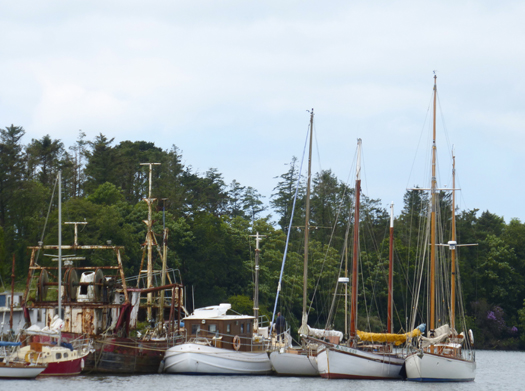
Boats in a row at Oldcourt. The further from the quay, the more ready for sea you are. Furthest out is the 1937 Tyrrell ketch Maybird, with which owner Darryl Hughes regularly attends the annual Yeats Summer School in Sligo. He's the only participant to arrive by sea, and he lives on board at the pontoon in Sligo during the Yeats festival. Photo: W M Nixon
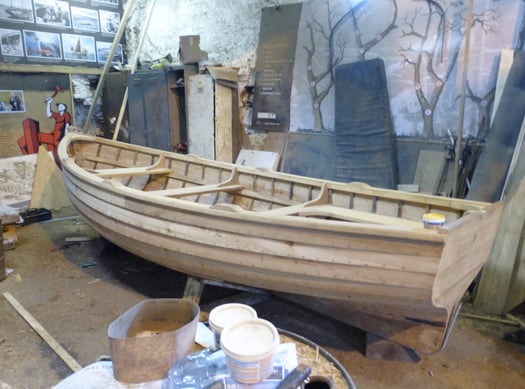
A new traditional clinker dinghy, built by John Hegarty of Oldcourt, awaits her first coast of varnish. Photo: W M Nixon
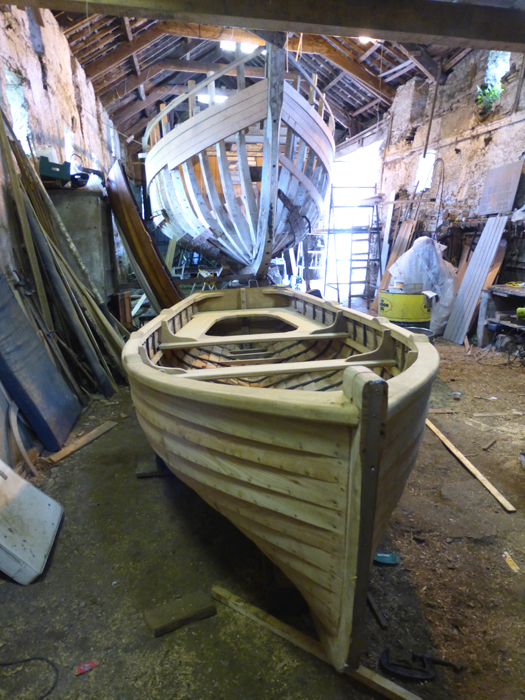
The new dinghy shares space with Conor O'Brien's Ilen, which continues to be a major work in progress. Photo: W M Nixon
Just to show what the result will be like, there was another recently-completed Hegarty dinghy in the Ilen shed, and very well it looked too. As for the restoration of Conor O'Brien's Ilen herself, that can best be described as ongoing. It has become such an absorbing task that the restoration process might best be thought of as an end in itself. Trying to work out what could most usefully be done with this hefty big lump of a boat if she ever is restored to seagoing condition is something which will require many brainstorming sessions, but it surely doesn't need to be considered in too much detail just yet.
The problem with the Ilen is she's too small for some things, and too big for others. She's of the same sort of in-between size which made the first Asgard of limited use as an official sail training vessel. Asgard was fine for teaching young people to sail, but she was simply too small to keep up with the tall ships which also completely overshadowed her in port, where Ireland's little ketch also failed to provide the necessary space and impressive setting for entertaining local bigwigs.
Manageability is the keynote to successful boat restorations. But Oldcourt is such a maritime universe that it can provide examples of what you'd think might have been eminently manageable restoration projects, yet they've ground to a halt. One such is Englyn, the creme de la crème of the boats amateur-designed by Harrison Butler, the English opthalmologist. In the 1930s, he was designing boats which successfully anticipated the highly-regarded designs of Lyle Hess more than forty years later, and the 26ft 6ins Englyn was so highly thought of by cruising guru Eric Hiscock that he included the design in his seminal book Cruising Under Sail, first published 1950.
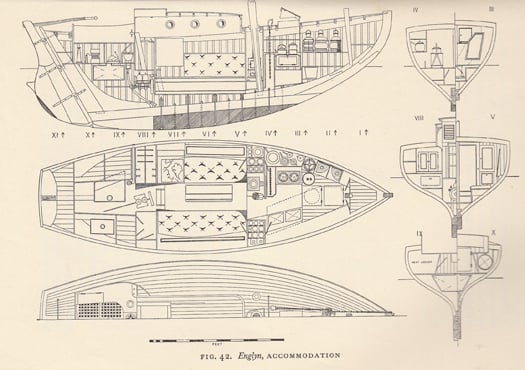
Plans of the Harrison Butler-designed Englyn, as featured in Eric Hiscock's Cruising Under Sail.
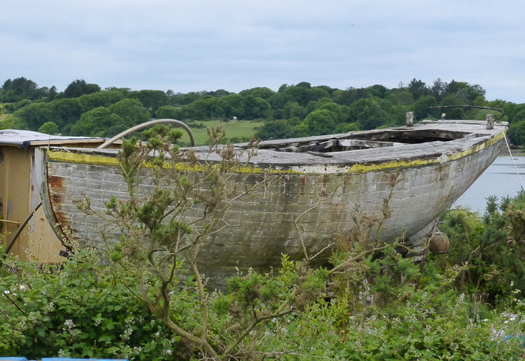
A little boat that may have missed the boat. Englyn as she is today. Photo: W M Nixon
If anything, the designs of Harrison Butler are more cherished than ever, and in this blog on May 10th we featured photos of the Harrison Butler Khamseen class cutter which ace boatbuilder Steve Morris is creating near Kilrush. It's heart-breaking to see the lines of Steve's healthy boat palely reflected in the weather-beaten remains of Englyn as she is today. But sometimes boats really can be brought back from the near-dead, and at the two-day Glandore Classic Boat Summer School in mid-July, the entire Sunday afternoon was given over to presentations about boats in various stages of restoration in and around Oldcourt.
Despite some unpleasantnesses visited upon it by the lingering death of the Celtic Tiger, Glandore gallantly soldiers on. Glandore Harbour Yacht Club's new headquarters in a cleverly rebuilt two-storey cottage up a side street (the only side street, as it happens) is appropriate to the good taste which prevails in this sweet place, whose name in Irish can mean either the golden harbour, or the harbour of the oaks - either will do very nicely.
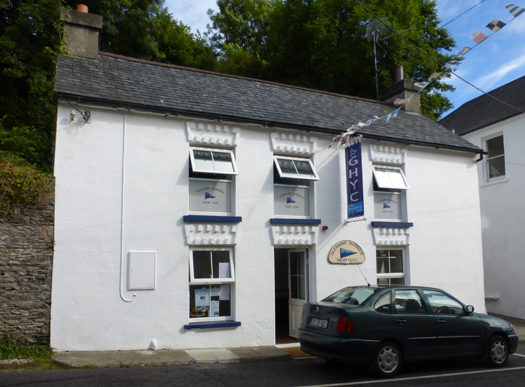
Glandore Harbour YC's clubhouse is now this cleverly re-built two-storey cottage beside the harbour. Photo: W M Nixon

The outboard dinghies waiting at the pontoon at Glandore Pier give a good indication of the number of boats based in Glandore and across the harbour at Union Hall. Photo: W M Nixon
The Summer School packed in an extraordinary variety of topics, and even this blogger was wheeled out to develop his thesis based around the ambiguous question: Why shouldn't the Irish be a seafaring people? Don't worry, for those who missed it, we'll push it out again here some time in the depth of winter. But we cannot hope to convey the full wonder of the best event in the Summer School, the question-and-answer session between ocean voyaging and offshore racing legend Don Street and his son Richard.
The old boy hasn't half been around. And if at some time your only experience of Don Street has been a high-pitched New England rant about some iniquity of modern yachting (fibreglass dismissed as "frozen snot", for instance) it's my happy duty to assure you that, as he delved into his extraordinary memories, the pitch of Don Street's distinctive voice became deeper and more resonant, until by the time he concluded all too early, we could have been listening to Captain Ahab himself.
From such a treasure trove of recollection, there were many gems, perhaps the best being about how he came to make his profession in writing about the sea and sailing. In his early days in the Caribbean before he'd put pen to paper, on one run ashore Don and his shipmates met up with Nobel Laureate John Steinbeck, and they'd a convivial time together. Later, heading back along the islands, they'd another dinner with the great writer, and during yarning at table, Don's shipmates insisted he'd so many good stories to tell that he should write them down.
"But I don't know how to spell, and I know nothing about grammar" complained Don.
"But you've a story to tell" said Steinbeck, "and you tell it well. Just you write it down, and the editors will sort out the spelling and the punctuation and the grammar. That's their job."
God be with the days......
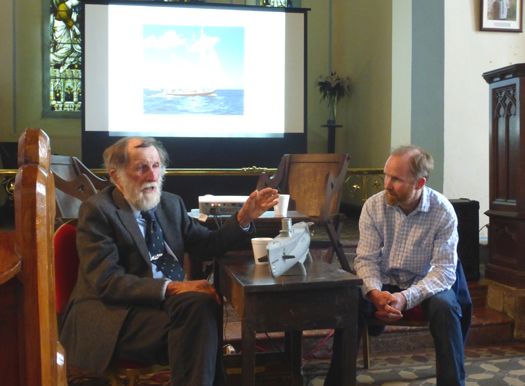
The old man of the sea – Don Street's reminiscences were the highlight of this year's Glandore Classic Boat Summer School. The school sessions were held in the harbourside church, and Don is seen here with his son Richard while he recalls his days in submarines in the US Navy. On the screen is his legendary 1905-built yawl Iolaire, in which he cruised the Caribbean and crossed the Atlantic. Photo: W M Nixon
Baltimore Sailing Club's Refurbished Clubhouse Opens
#baltimore – The village of Baltimore in West Cork was en fête yesterday (20th July 2014) with the opening of the newly-rebuilt clubhouse for Baltimore Sailing Club by Simon Coveney TD, Minister for Agriculture, Food, the Marine & Defence.
The opening follows a proposed Fáilte Ireland sale of the former Glenans sail training school premises in the West Cork town.
As Afloat.ie reported in April the new West Cork club house has been greatly welcomed by Irish sailing and yesterday, the scenic fishing village played host to hundreds of local and national sailors, visitors to the region and the local community, who were hugely supportive of the development of new Clubhouse and its facilities, which embraces all levels of sailing and encourages activity in the waters of the Carbery's 100 isles surrounding Baltimore. St. Fachtna's Silver Band from Skibbereen added to the carnival atmosphere, performing in the open air, with the stunning backdrop of Baltimore and the islands behind and boats of all shapes and sizes rafted up to complete the picture.
Minister Coveney stated: 'Baltimore is a very special place in West Cork, and the vibrancy is palpable from the moment one arrives here. There is an obvious high level of co-operation between the various groups in the village and its hinterland, culminating in the re-building of this impressive structure, offering outstanding facilities for locals and visitors. The Government and its agencies including West Cork Development Partnership, and Cork County Council, are delighted to lend support to the project, in the knowledge that it is significantly improving marine infrastructure in Baltimore. The Government has also supported the building of the new pier and service buildings in Baltimore, and I feel sure that, in the future, this harbour will see many new developments for the better in this wonderful part of west Cork'.
'This project is a testament to a fantastic volunteer effort by our members, supported by the people of Baltimore, and supporters and friends from many walks of life. In particular I'd like to pay tribute to Tony O'Driscoll, my predecessor as Commodore of the Club, whose relentless enthusiasm and hard work saw this project cross the line in jig time.' said Joan Collins, Commodore of the Baltimore Sailing Club.
Joan added: 'Baltimore has retained its friendly village atmosphere and this new clubhouse adds to the offering, with year round activity to encourage people to get on the water and enjoy the freedom of the waters of West Cork. The re-furbishment will be a great boost for our sailing fraternity, and we now have an option to host our events with style, while encouraging additional events which can only be of definite benefit to the Baltimore and greater West Cork area.
The Club is a vibrant and active summer club and has, and will, host several prestigious sailing events. With sailing every weekend throughout the summer and additional events out of season including at Easter (Laser Munsters), the National 18ft Class over June bank holiday weekend this year, and the Optimist Coaching week in February, we will hold many other great events later this year.'
Designed by architect John McCarthy and built by local builder, Michael Joe Leonard, the new Clubhouse space incorporates enhanced facilities for members and visiting sailors, including a new shower block (15 showers) and spaces facilitating events, training, seminars and storage and improved dingy parking. Totally transformed, and re-built at a cost of €400,000, the Club was supported by Cork County Council and West Cork Development Partnership, with match funding provided by the Club itself and by donations from members and the general public. Founded in 1952, Baltimore Sailing Club has over 600 members drawn from the locality and other regions, including several overseas members.
Baltimore is renowned for its sailing courses for children of all levels (85 children availing of this currently), and the Rambler Team Racing for junior club members is very popular again this year. Junior sailors from Crookhaven, Schull, Glandore and Baltimore are also involved in the inter-club Marconi Cup team racing event bringing communities closer together in the region. There is a course for adults in train this year also, and it is hoped to build on this offering into the future.
Sailing events in Baltimore include Baltimore Sailing Club Regatta will take place over the August bank holiday weekend, as will the 1720 Club. The inaugural WOMEN ON THE WATER (WOW) event on August 12th in aid of Breakthrough Cancer Research (part of Cork Cancer Research Centre) will see craft of all shapes and sizes on the water, with onshore fun for all the family. Sponsorship cards are available at the clubhouse and Commodore Collins is confident this event will raise a substantial amount for cancer research.
The Club will also participate in Bart's Bash, one of the first clubs in Ireland to register for this massive world-wide charity event. The clubhouse will also be used by local organisations such as the Baltimore Bridge Club, RNLI, local festival groups and defibrillator personnel, truly embracing all strands of society in the area.
Body Of Missing Diver Found Off Baltimore
#Diving - Search teams have found the body of a diver who went missing off West Cork early yesterday (2 July) after an incident that lead to the death of another diver.
As previously reported on Afloat.ie, a major search and rescue operation was launched after the accident at a wreck site off the Baltimore area.
According to Independent.ie, the two deceased men were in their 60s and understood to be experienced diving enthusiasts, who had been exploring the wreck of a German U-Boat that sank off Castlehaven in 1945.
Both men, from England, were described as regular visitors to the Baltimore area since the late 1970s.
Independent.ie has more on the story HERE.
#maritimefestival – There will be a number of maritime themed events at the 2014 West Cork Literary Festival in Bantry, Co. Cork which runs from Monday, July 7th to Friday, July 11th with many free events.
On Friday July 11th in Bantry Library Rose George, the winner of the 2013 Mountbatten Maritime Award for Best Literary Contribution, will give a free talk about her fascinating journey into the hidden world of shipping. Her pursuit of the shadowy truths behind the industry that brings us almost everything we eat, wear, and work with, took her across the globe. "Deep Sea and Foreign Going: Inside Shipping, the Invisible Industry that Brings You 90% of Everything" is essential reading for anyone curious about the complex systems behind our convenient modern world. She follows the routes travelled by mercantile and naval fleets, pirate gangs, and illegal floating factories.
Philip Hoare will read from his yearlong adventure through the world's oceans. "The Sea Inside" on Thursday, July 10th. In colourful prose and lively line drawings, he sets out to rediscover the sea and its islands, birds, and beasts. Starting at his home on the shores of Britain's Southampton Water and moving in ever widening circles—like the migration patterns of whales—Hoare explores London, the Isle of Wight, the Azores, Sri Lanka, Tasmania, and New Zealand. Philip, winner of the 2009 Samuel Johnson Prize for non-fiction, is a broadcaster and author, he wrote and presented the BBC Arena film, "The Hunt for Moby-Dick", and directed three films for BBC's Whale Night.
On Saturday, July 12th there will be a special event on Whiddy Island, starting with the ferry across we celebrate Bantry Bay, the sea beyond and the lore and poetry of West Cork. John Mack, author of "The Sea: A Cultural History" draws on histories, maritime archaeology, art history and great literature to provide an innovative account of the great blue yonder and his own love for Whiddy. Philip Hoare will read from "Leviathan or, The Whale" his award winning book and film, which is also the story of our own obsessions. Leanne O'Sullivan from the Beara Peninsula will read from her poetry collections "Cailleach, The Hag of Beara" and "The Mining Road". She is the recipient of The Rooney Ireland Chair of Poetry Bursary and Lawrence O'Shaughnessy Awards.
Of course, younger readers are looked after too with the interactive Monster Sea Doodle! Travel 50 leagues under the sea with Captain Olivia Golden, illustrator extraordinaire, and learn how to draw some of the creatures that tickle, wriggle and swim in the salt water off the Bantry coast. Monster Sea Doodle! Takes place on Tuesday, July 8th, in St Brendan's School Hall
Ben Okri, Jonathan Miller, Blake Morrison, Karen Joy Fowler and Jennifer Johnston are just some of the guests announced for the renowned West Cork Literary Festival this July. The West Cork Literary Festival runs from July 6th to 12th and is generously supported by The Arts Council, Cork County Library and Arts Service and Fáilte Ireland. Booking on www.westcorkliteraryfestival.ie, Telephone: 027 52788/9
#MarineWildlife - A tip of the hat to @BestBaltimore on Twitter for this video of a dolphin 'superpod' that congregated outside Baltimore Harbour in West Cork yesterday (Thursday 15 May).
Such superpods can comprise as many as 1,000 or more dolphins - so the vast numbers seen here breaching the surface may only have been a fraction of a much larger group.
Early last year researchers captured video of a superpod hundreds of dolphins strong in the Irish Sea, with one describing the scene as "boiling" with the gregarious marine mammals.




























